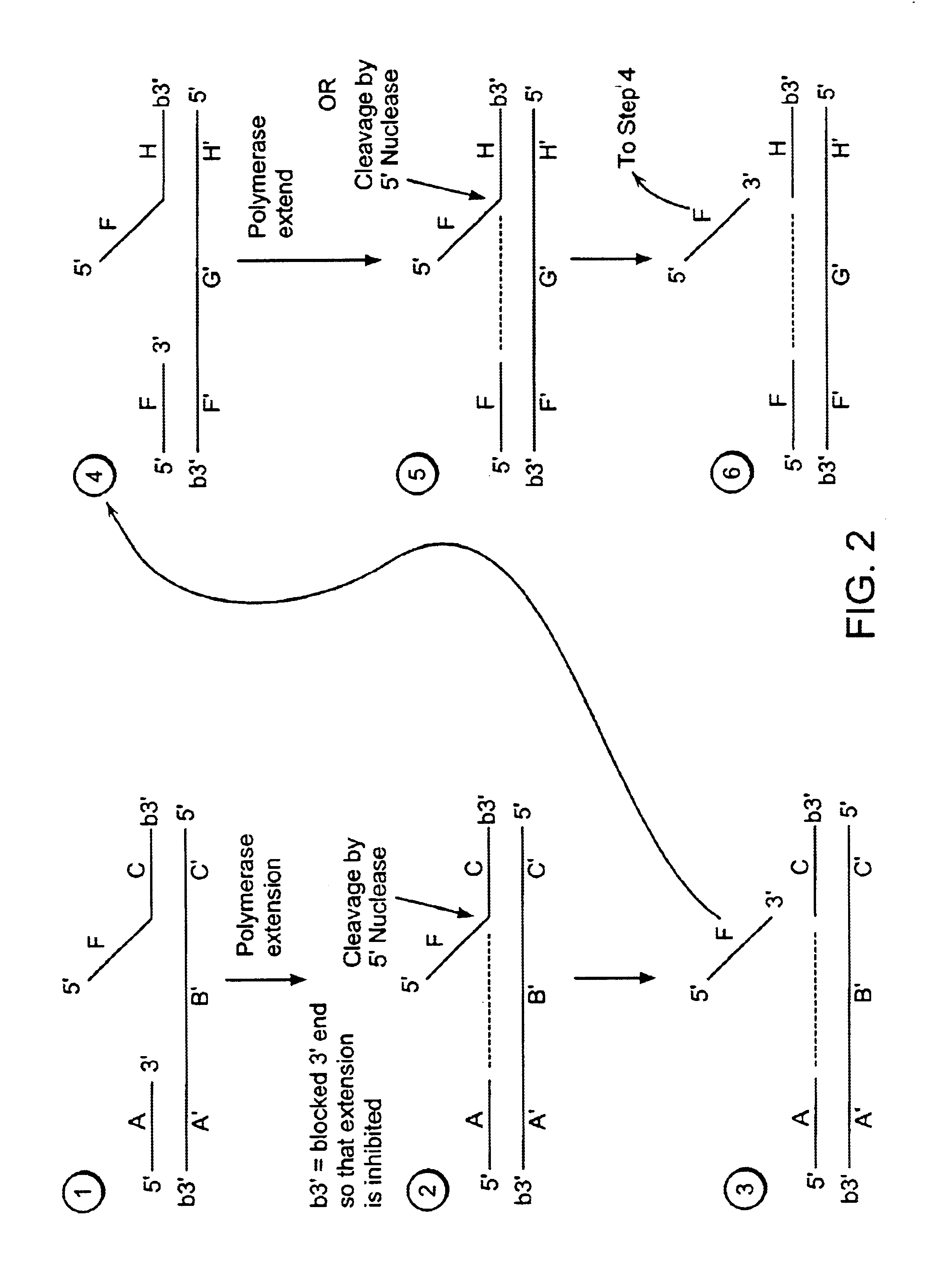Methods for detection of a nucleic acid by sequential amplification
a nucleic acid and sequence technology, applied in the field of sequence amplification of nucleic acids, can solve the problems of inability to activate mutations in the poli 5 3′ exonuclease domain, and the need for additional manipulation of amplified materials
- Summary
- Abstract
- Description
- Claims
- Application Information
AI Technical Summary
Benefits of technology
Problems solved by technology
Method used
Image
Examples
example 1
Linear Isothermal Amplification
[0488]A target nucleic acid sequence can be detected and / or measured by the following method of linear isothermal amplification.
[0489]Step 1:
[0490]A labeled first duplex is formed prior to the addition of a nuclease by incubating a sample containing a target nucleic acid (A′B′C′, FIG. 2), a downstream, 5′ radioactively, end labeled second oligonucleotide (FC, FIG. 2) comprising a 5′ region that is not complementary to the target nucleic acid sequence, and an upstream first oligonucleotide (A, FIG. 2) under conditions that permit hybridization and formation of a first duplex wherein the 5′ region of the second oligonucleotide is a flap and the extension region of the target nucleic acid is not hybridized to the flap. For example, the sample is heated at 95° C. for 5 minutes and then cooled to approximately 50-60° C. Alternatively, the target nucleic acid, the second oligonucleotide and the first oligonucleotide are hybridized at a temperature (for examp...
example 2
Linear Isothermal Amplification
[0513]A target nucleic acid sequence can be detected and / or measured by the following method of linear isothermal amplification.
[0514]Step 1:
[0515]A labeled first duplex is formed prior to the addition of a nuclease by incubating a sample containing a target nucleic acid (A′B′C′, FIG. 2), a downstream, 5′ radioactively, end labeled second oligonucleotide (FC, FIG. 2) comprising a 5′ region that is complementary to the target nucleic acid sequence, and an upstream first oligonucleotide (A, FIG. 2) under conditions that permit hybridization and formation of a first duplex wherein the 5′ region of the second oligonucleotide is hybridized to the target nucleic acid. For example, the sample is heated at 95° C. for 5 minutes and then cooled to approximately 50-60° C. The first and second oligonucleotide hybridize to non-overlapping regions of the target nucleic acid. Alternatively, the target nucleic acid, the second oligonucleotide and the first oligonucleo...
example 3
Exponential Isothermal Amplification
[0538]A target nucleic acid sequence can be detected and / or measured by the following method of exponential isothermal amplification.
[0539]Steps 1-3 of Example 1 are performed.
[0540]Step 4:
[0541]A labeled second duplex is formed as follows. A sample containing a template nucleic acid (F′G1′H1′G2′H2′, FIG. 5), an upstream, 5′ radioactively, end labeled third oligonucleotide (FH1, FIG. 5) comprising a 5′ region that is not complementary to the template nucleic acid sequence, and an upstream, 5′ radioactively, end labeled fourth oligonucleotide (FH2, FIG. 5) comprising a 5′ region that is not complementary to the template nucleic acid sequence, is incubated under conditions that permit hybridization of the template nucleic acid and the third and fourth oligonucleotides (as described in Step 1 of Example 1). The hybridized template nucleic acid / third and fourth oligonucleotides is combined with an amount of the sample containing the cleavage products ...
PUM
| Property | Measurement | Unit |
|---|---|---|
| Temperature | aaaaa | aaaaa |
| Temperature | aaaaa | aaaaa |
| Volume | aaaaa | aaaaa |
Abstract
Description
Claims
Application Information
 Login to View More
Login to View More - R&D
- Intellectual Property
- Life Sciences
- Materials
- Tech Scout
- Unparalleled Data Quality
- Higher Quality Content
- 60% Fewer Hallucinations
Browse by: Latest US Patents, China's latest patents, Technical Efficacy Thesaurus, Application Domain, Technology Topic, Popular Technical Reports.
© 2025 PatSnap. All rights reserved.Legal|Privacy policy|Modern Slavery Act Transparency Statement|Sitemap|About US| Contact US: help@patsnap.com



